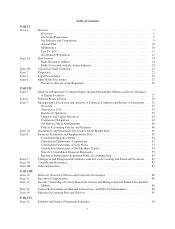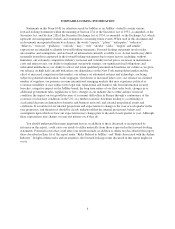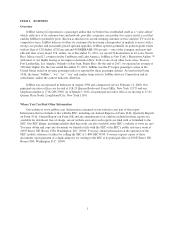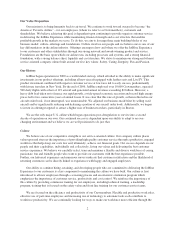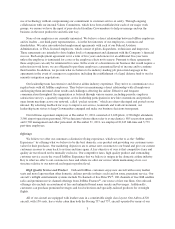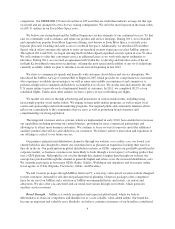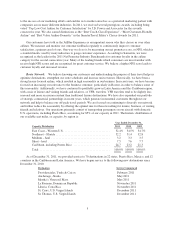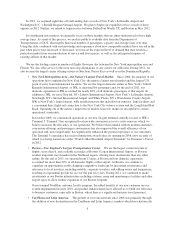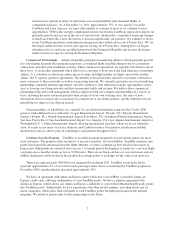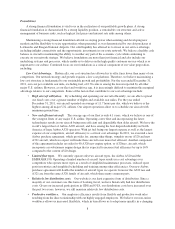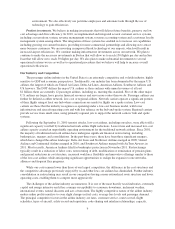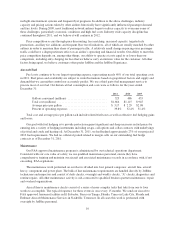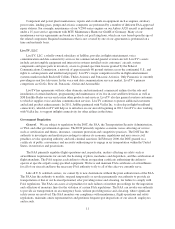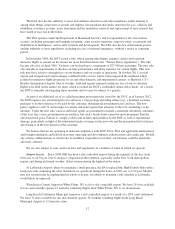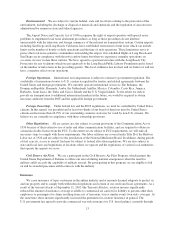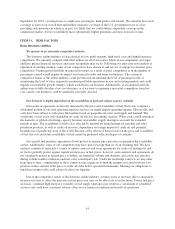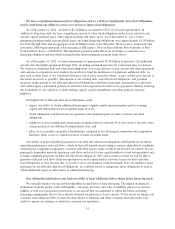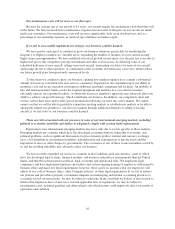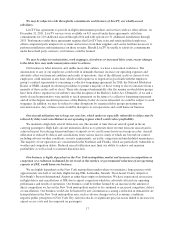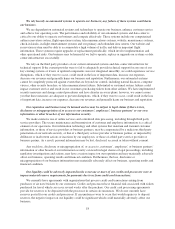JetBlue Airlines 2011 Annual Report Download - page 18
Download and view the complete annual report
Please find page 18 of the 2011 JetBlue Airlines annual report below. You can navigate through the pages in the report by either clicking on the pages listed below, or by using the keyword search tool below to find specific information within the annual report.Foundations
A strong financial foundation is vital to us in the realization of our profitable growth plans. A strong
financial foundation is characterized by a strong liquidity position, a sustainable cost structure and active
management of business risks, such as high jet fuel prices and interest rate risks among others.
Maintaining a strong financial foundation affords us staying power when entering and developing new
markets and the flexibility to seize opportunities when presented, as was demonstrated by our slot purchases at
LaGuardia and Reagan National Airports. Our solid liquidity has allowed us to invest in our service offerings,
including inflight connectivity and the opportunistic investments in our route network. We believe a healthy cash
balance is crucial to maintaining the ability to weather any part of the economic cycle while continuing to
execute on our network strategy. We believe foundations are more than just financial and also include our
underlying systems and processes, which enable us to deliver on the high quality customer service which is so
important to our culture. Continued focus on our foundations is a critical component of our value proposition,
including:
Low Cost Advantage. Historically, our cost structure has allowed us to offer fares lower than many of our
competitors. Our network strategy and growth requires a low cost platform. Therefore, we believe maintaining a
low cost structure is fundamental to our sustainable growth and profitability. For the year ended December 31,
2011, our cost per available seat mile, excluding fuel, of 6.76 cents is among the lowest reported by all other
major U.S. airlines. However, as our fleet and workforce age, it is increasingly difficult to maintain this marginal
advantage relative to our competitors. Some of the factors that contribute to our cost advantage include:
•High aircraft utilization. By scheduling and operating our aircraft efficiently, we are able to spread
our fixed costs over a greater number of flights and available seat miles. For the year ended
December 31, 2011, our aircraft operated an average of 11.7 hours per day, which we believe is the
highest among all major U.S. airlines. Our airport operations allow us to schedule our aircraft with
minimum ground time.
•New and efficient aircraft. The average age of our fleet is only 6.1 years, which we believe is one of
the youngest fleets of any major U.S. airline. Operating a new fleet and incorporating the latest
technologies results in our aircraft being more efficient and dependable than older aircraft. We have the
world’s largest fleet of Airbus A320 aircraft, and have among the best dispatch reliability in North
America of large Airbus A320 operators. With jet fuel being our largest expense as well as the largest
expense of our competitors, aircraft efficiency is a critical cost advantage. In 2011, we executed a new
Airbus purchase agreement, which provides for, among other things, winglets on our A320 and new
A321 aircraft, which we expect will make these aircraft even more fuel efficient. Another component
of this agreement includes an order for 40 A320 new engine option, or A320neo, aircraft, which
incorporate a revolutionary engine design that is expected to increase fuel efficiency by up to 16%
compared to the current A320 design.
•Limited fleet types. We currently operate only two aircraft types, the Airbus A320 and the
EMBRAER 190. Operating a limited number of aircraft types results in a cost advantage over
competitors who operate more types as a result of simplified maintenance processes, reduced spare
parts inventories and simplified scheduling and training among other efficiencies. Our new Airbus
purchase agreement will double the number of aircraft types we operate; however the A320 neo and
A321 are from the same A320 family of aircraft, which share many common parts.
•Relatively low distribution costs. Our website is our least expensive form of distribution. Since a
majority of our customers use this form of booking travel, we have historically had low distribution
costs. Given our increased participation in GDS and OTA, our distribution costs have increased over
the past two years; however, we still maintain relatively low distribution costs.
•Productive workforce. Our employee efficiency results from flexible and productive work rules
resulting from the direct relationship with our highly engaged employees. We believe our non-union
workforce allows us increased flexibility, which in turn allows us to adapt more quickly in a changing
8



